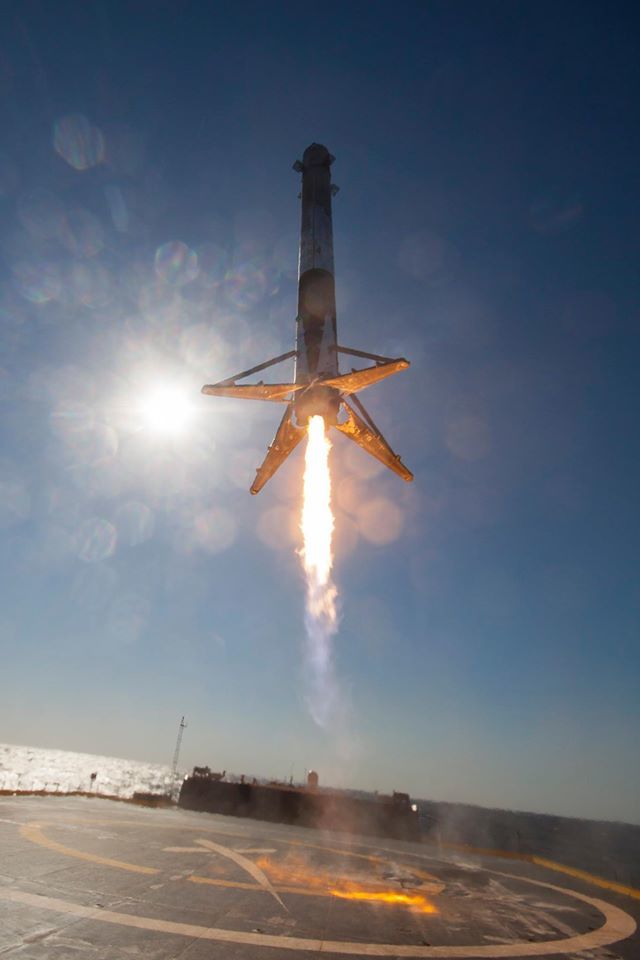Spasex has set a deadline for the secondary launch of the “proven in space” stage of the Falcon 9

The landing of the first stage of the Falcon 9 rocket of the CRS-8 mission on the offshore platform on April 8, 2016. It is this stage that will fly into space again. Photo: SpaceX
Many experts from the aerospace industry doubt that SpaceX is able to re-launch the returned stage of the Falcon 9 launch vehicle and drastically reduce the cost of putting the cargo into orbit. There are concerns that re-use will reduce the reliability of the launch, and inspection and repair of the returned stage is supposedly too expensive.
SpaceX intends to dispel these doubts. Yesterday, the company announced an agreement with SES to bring the SES-10 communications satellite to a geostationary orbit in the 4th quarter. 2016 The very first stage with serial number 1021, which successfully returned on April 8, 2016 from flight number F9-023 ( SpaceX CRS-8 mission) for the delivery of an expandable BEAM module and other cargo to the ISS, will be sent to space - and then made the first in space history successful landing on an offshore platform .
The agreement reached on the launch of the return stage of the launch vehicle means that customers are ready to entrust their equipment to re-launch the reusable rocket. Insurance companies have decided on tariffs for such a service, based on a new risk assessment. And the client himself was satisfied with the price reduction. Prior to the conclusion of the transaction, SES representatives stated that they would like to reduce the price by about 30% compared with the previous cost of $ 60 million. It can be assumed that the current launch of SES-10 will cost the client approximately $ 40 million.
')
And then - the first in the history of re-return to Earth. I wonder how many launches this rocket will endure and to what extent will the launch cost decrease?
SES-10 communication satellite
The SES-10 communications satellite will be deployed over South America at orbit position 67 West longitude, in accordance with an agreement with the Andean countries. The spacecraft will be part of the Simón Bolivar 2 satellite network. The satellite is equipped with a set of 55 Ku-band transponders in the equivalent of 36 MHz, of which 27 transponders are increasing.
The SES-10 satellite is being developed by Airbus Defense and Space on the Eurostar E3000 platform. It has an electric plasma engine for orbital maneuvers and a chemical engine for lifting into orbit and orbital maneuvers.
“The re-launch of the rocket, which had once launched a spacecraft into orbit, is an important milestone on the way to creating a full-fledged technology for the rapid and multiple use of rockets,” said Gwynn Shotville, President and CEO of SpaceX.
In Russia, the development of a returnable first stage of a launch vehicle was carried out many years ago, but it was frozen because of its “futility”. Only in the summer of 2016 (after several successful landings of Falcon 9), the Khrunichev Center decided to restore the department for reusable launch vehicles and reassemble the team of specialists who developed the Energy-Buran system.
True, the experience of Ilona Mask of the Russian specialists “did not inspire”, so they design the “winged” first stage, which can return to the cosmodrome as an airplane and land on the runway.
Let's see if the opinion of Russian specialists will change after the first restart of the SpaceX return stage. It will be a difficult mission. The satellite is very heavy - the weight is 5300 kg , the first step was slightly damaged during the first landing, and again she would have to land on a tiny barge (there is not enough fuel to get to land). More difficult nowhere. Probably, the probability of a successful landing in such conditions will not be very high. Let's see how Falcon 9 does it.

The landing of the first stage of the Falcon 9 missile of the CRS-8 mission on the offshore platform on April 8, 2016 Photo: SpaceX
Let us hope that this time the video transmission from the barge will not be interrupted at the time of landing, as it happened more than once due to the powerful vibration of the satellite antenna, which cannot be directed to the satellite.
Video from the last landing Falcon 9 did not show. Employees of SpaceX are thinking about solving this problem: according to unofficial information, next to the barge they can launch a helicopter for video shooting, if the company has extra money. As a cheaper option, you can run a couple of drones from a rented fishing schooner.
The exact launch date of SES-10 is not yet known, but the technology director of SES hopes to launch a satellite in October 2016. By the way, in this interview, following the link, he said that the insurance premium and insurance coverage for this launch remained the same. That is, insurance companies do not believe that re-use of the first stage increases the risk. If the insurance really remains on the same conditions - this is great news! It is possible to congratulate Ilona Mask and the engineers who managed to prove to the insurance companies the reliability of the mechanisms.
Source: https://habr.com/ru/post/369625/
All Articles